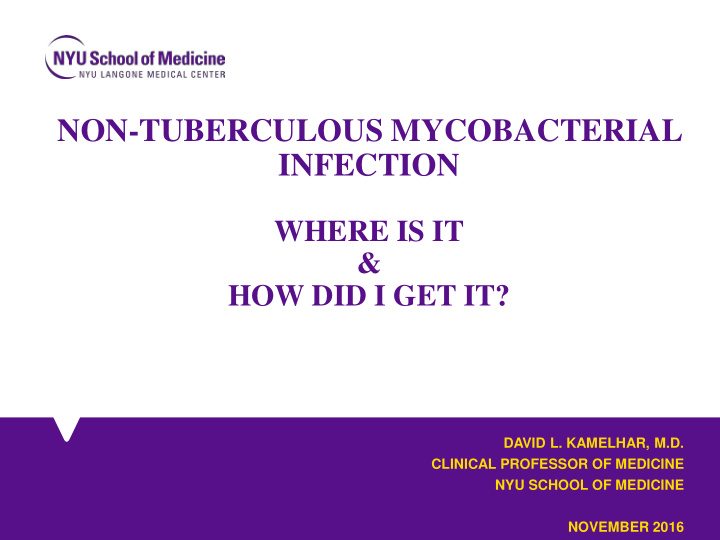



NON-TUBERCULOUS MYCOBACTERIAL INFECTION WHERE IS IT & HOW DID I GET IT? DAVID L. KAMELHAR, M.D. CLINICAL PROFESSOR OF MEDICINE NYU SCHOOL OF MEDICINE NOVEMBER 2016
GOALS OF TALK • Identify sources of NTM in the environment • Clarify the reasons that it is difficult to remove NTM from the household environment and thus why avoidance of NTM is “easier said than done” • Gain perspective on whether the personal environment is the pivotal factor in acquiring the infection
GOALS OF THE TALK SEGUE TO LATER TALKS EMPHASIZING THAT • INHALATION OF VAPOR IS NOT THE ONLY MECHANISM PROPOSED ESOPHAGEAL AND SWALLOWING DYSFUNCTION • MAY PLAY A ROLE AS WELL THE NOTION OF THE “SUSCEPTIBLE PATIENT” • MODEL
DIFFERENT LEVELS OF BACKGROUND KNOWLEDGE • Commitment to the concept that “knowledge is power” • Many know this material • May be complex • Apologies for discrepancy in level of information included
WATERBORNE ORGANISMS Enteric organisms • Grow within the gastrointestinal tract • Well understood • Cholera first recognized organism • Spread by poor sanitation, diarrheal illnesses • Managed by centralized water systems, sanitation
OPPP’S “ Opportunistic premise plumbing pathogens” Saprozoic organisms • Grow within engineered water systems • Less well understood • Not human-to-human spread
SAPROZOIC ORGANISMS • Most recognized health-related organisms • Non-tuberculous mycobacteria • Legionella • Pseudomonas • Aspergillus
SAPROZOIC ORGANISMS • Grow within biofilms and sediments, not freely • Cannot be controlled by water treatment alone prior to entry into the water distribution and other engineered water systems • May be viruses, bacteria, fungi and protozoal diseases • Legionella grows within free-living protozoa that reside in the biofilm • Not all such organisms are pathogenic – “nature” • Need to understand biofilms to prevail
BIOFILM The slimy film that coats all (non-copper) pipes • All water mains, pipes leading to the home and in the • home have them Amoebae live there as well and NTM live in them • All but impossible to eliminate • BTW: Plastic rather than copper pipes proposed as a reason for uptick in NTM from showers, etc.
BIOFILM AND NTM M. abscessus less adherent than M. avium and M. intracellulare on surfaces
THE LARGER ‘NON-PERSONAL” ENVIRONMENT • May have more influence than the water at home! • Harder still to control/ influence • Likely explains differences in geographic distribution of M. avium vs. M. kansasii, etc.
RELATIVE RISK OF CLUSTERS OF PULMONARY NTM AMONG MEDICARE BENEFICIARIES High risk • Highlands, FL 1.9 • Santa Barbara, CA 2.0 • New York, NY 2.7 • Kalawao, HI 3.7 • Plaquemines, LA 6.5 Low risk • Washington, RI 0.5 • Iosco, MI 0.4 • Roane, WV 0.4
EVAPOTRANSPIRATION “ The process by which water is transferred from the land to the atmosphere by evaporation from the soil and other surfaces and by transpiration from plants”
NTM CLUSTER ANALYSIS • Proportion of area as surface water • Mean daily “evapotranspiration” • However the overall risk is still very low • Therefore both environmental AND host susceptibility factors must be considered in identifying risk factors for PNTM disease
NIH 2012 – Adjemian, continued ASIAN- PACIFIC > WHITES • 228 VS. 116/ 100,000 WESTERN STATES > EASTERN • 149 VS 131 WOMEN > MEN • 1.4 TO 1.0 Within the same environment, intrinsic factors are operative as well
SAPROZOIC ORGANISMS INDOOR CONTROL MEASURES • Central water reservoirs • Regional water distribution systems • Individual homes • Public spaces
NTM HABITATS • NATURAL WATERS • DRINKING WATER HOUSEHOLDS • • AEROSOLS • Shower heads and water taps • WATER FILTERS • ROOM HUMIDIFIERS • SOILS • DUSTS • BIOFILM FEATURE KEY IN HUMAN WATER
IMPEDIMENTS TO FREEING THE ENVIRONMENT OF NTM NTM RESISTANT TO TEMPERATURES ACHIEVED IN HOT WATER HEATERS MORE HEAT RESISTANT THAN LEGIONELLA PNEUMOPHILA WATER HEATER @ • 50C (122F): 50 HOURS TO REDUCE 1000 NTM ORGANISMS/ml TO 1 ORGANISM • 55C (131F) 2.7 HOURS • 60C (144F) 12 MINUTES
IMPEDIMENTS TO FREEING THE ENVIRONMENT OF NTM LIPID –RICH OUTER MEMBRANE • Hydrophobic (water repelling) cell surface • On bubble/ aerosol surfaces not freely in water • Surface attachment/ biofilm formation • Impermeable to hydrophilic (water attracting) nutrients • Resistant to disinfectants • Resistant to antibiotics • Slow growth
NTM ERADICATION The harder we try to eradicate NTM, the more we select for them as we succeed in eradicating competing organisms, allowing NTM to flourish
NTM “AVOIDANCE” INDIVIDUAL EXPOSURES TO POTENTIAL SOURCES OF NTM AND THEIR ASSOCIATION WITH INFECTION • Very few individual behaviors associated with incident NTM infection • Strong association of atmospheric water content within a geographic area Only individual behaviors: • Indoor swimming • Living in a single family residence • Reporting rusty pipes from household plumbing
NTM “AVOIDANCE” • No soil-exposure associated infection • Non-CF studies: Florida 2006 study found that 6 or more years of soil-related work is associated with PNTM • 2012 Winthrop study-Pacific NW states- only individual activity association is using a spray bottle to spray plants • NO association with indoor swimming pools
CONCLUSIONS FOR NOW • Environmental AND host factors • Water and water vapor involved • Aerosol • Biofilm Uncertain which individual exposure(s) and behaviors are involved
ENVIRONMENT OR HOST? CONCLUSIONS • FAVOR A “SUSCEPTIBLE PERSONS” MODEL OF MAC DISEASE ACQUISITION • HOST FACTORS OUTWEIGH “BEHAVIORAL FACTORS” • BODY MORPHOTYPE CONFIRMED – BACK TO BASICS!
• AEROSOL-GENERATING ACTIVITIES ARE NOT UNIVERSALLY ACCEPTED AS CAUSAL IN ACQUISITION OF MAC INFECTION IN HIV- NEGATIVE POPULATION
CONCLUSIONS FOR NOVEMBER 2016 TOO EARLY TO DRAW BROAD CONCLUSIONS REGARDING RISK OF SHOWERING OR OTHER WATER EXPOSURE IN PATIENTS WITH NTM LUNG DISEASE AND BRONCHIECTASIS Aksamit, Philley and Griffith, 2013
CONCLUSIONS FOR NOVEMBER 2016 TWO HIT HYPOTHESIS Environmental • Organism virulence • Organism exposure burden · Environment – Micro and Macro · Ingestion/ aspiration · Altering the microbiome Genetic • Single gene • Polygenic
THANK YOU FOR LISTENING
Recommend
More recommend